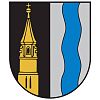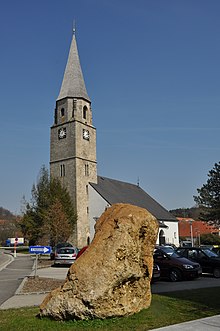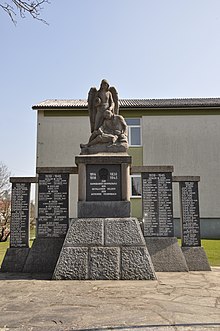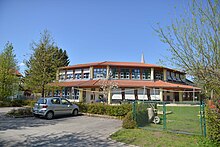Mehrnbach
|
Mehrnbach
|
||
|---|---|---|
| coat of arms | Austria map | |
|
|
||
| Basic data | ||
| Country: | Austria | |
| State : | Upper Austria | |
| Political District : | Ried im Innkreis | |
| License plate : | RI | |
| Surface: | 22.21 km² | |
| Coordinates : | 48 ° 12 ' N , 13 ° 26' E | |
| Height : | 443 m above sea level A. | |
| Residents : | 2,361 (Jan 1, 2020) | |
| Population density : | 106 inhabitants per km² | |
| Postal code : | 4941 | |
| Area code : | 07752 | |
| Community code : | 4 12 14 | |
| NUTS region | AT311 | |
| Address of the municipal administration: |
Mehrnbach 80 4941 Mehrnbach |
|
| Website: | ||
| politics | ||
| Mayor : | Georg Stieglmayr ( ÖVP ) | |
|
Municipal Council : (2015) (25 members) |
||
| Location of Mehrnbach in the Ried im Innkreis district | ||
| Source: Municipal data from Statistics Austria | ||
Mehrnbach is a municipality in Upper Austria in the district of Ried im Innkreis in the Innviertel with 2361 inhabitants (as of January 1, 2020). The community is located in the judicial district of Ried im Innkreis .
geography
Mehrnbach is 443 m above sea level in the Innviertel. The extension is 6.2 km from north to south and 6.5 km from west to east. The total area is 22.2 km². 14.9% of the area is forested, 73.9% of the area is used for agriculture.
Localities of the municipality of Mehrnbach
The municipality includes the following localities (population in brackets as of January 1, 2020):
- Dish (57)
- Aich (64) including Schwarzenstrasse
- Asenham (82)
- Atzing (78)
- Aubach (113)
- Aubachberg (191)
- Baching (45)
- Bubesting (16)
- Double lift (29) including Zur Alm
- Fritzging (60)
- Gigling (36)
- Beetle Mill (100)
- Langdorf (76)
- Mehrnbach (1013)
- Probing (41)
- Renetsham (117)
- Riegerting (37)
- Sieve (83)
- Steinbach (19)
- Stötten (31)
- Thaling (25)
- Zimetsberg (48) including Blindenhofen
Neighboring communities
| Wippenham | Eitzing | Aurolzmünster |
| Kirchheim im Innkreis |

|
Ried im Innkreis |
| Mettmach | Lohnsburg | Neuhofen im Innkreis |
Population development

The strong increase in the population between 1991 and 2001 occurred despite a negative migration balance , as the birth balance was very positive (+342). After 2001, emigration remained the same, but the birth rate fell, so that the population only rose slightly.
history
History between 500 and 1800
The Bavarians immigrated to the region around 1500 years ago . Their leader Itzo settled with some of his people in Eitzing . Another part moved to the source of the Mehrnbach. At that time the following localities were founded: Atzo - Atzing, Fritz - Fritzging, Reno - Renetsham and Aso - Asenham. Dense forest initially covered the area of Baching, Bubesting, Sieber, Gigling and Dopplhub. This area is still called Oberholz today.
The Mehrbach settlement was established in 526. Construction of the first St. Martin's Church began in 788 and was consecrated in 911. The Merenbach estate was first mentioned in a document in 1140, the place Meranpach was mentioned in a document in 1160. Mernpach was recorded in records in 1253 as the mother parish of Ried . In 1340 a regional court was established in Ried. Mehrnbach was separated from Ried in the 14th century, and the Swaikkersberg (Schweiklberg) farm was also mentioned in a document in this century. In the 16th century the aisles of the current three-aisled church were built.
History from 1800
In the course of the French Wars, on December 18, 1800, the Austrian hussars fought against the French army on Schweiklberg ( Battle of Mehrnbach ). On October 30, 1805, the first French army rode through Mehrnbach and took possession of Ried. On November 2nd, 1805, Napoleon , coming from Braunau, moved through Mehrnbach to Ried. The withdrawal of the French troops then took place in January 1810.
On August 23, 1814, a beheading took place in what was then Riedholz on the way from Ried to Renetsham in the municipality of Mehrnbach.
Also in 1814, after the pastor from Mehrnbach moved his seat to Ried in 1518, Mehrnbach again became an independent parish. Due to the poor harvest, famine broke out in the region in 1816.
The music band was founded in 1851 by master carpenter Mathias Sperl.
In 1857 construction began on the schoolhouse, which was inaugurated on November 11, 1858. This was followed in 1870 by the construction of the Neumarkt-Simbach railway through the municipality of Mehrnbach. In 1887, the stop was put into operation after the construction work was completed.
The municipality of Eitzing was separated from the political municipality of Mehrnbach in 1881. On May 26, 1888 Archduke Albrecht visited the Loderbauerngut on the occasion of a maneuver with several generals. In 1891, Mehrnbach was legally its own parish again.
On July 24, 1898 Tower Cross Aufsteckungsfeier took place on the occasion of the 50th jubilee of Emperor Franz Josef I .
At the beginning of the First World War , 138 military and landstorm compulsory soldiers of the community marched in on August 1, 1914, and another 98 men followed later. 48 soldiers did not come home after the end of the war in 1918. On January 11th, 1920, a returnees party was celebrated and the emergency banknote was issued.
In the census carried out in 1920 there were already 1,744 inhabitants in the municipality of Mehrnbach.
On November 27, 1921, the bells were consecrated (the bell godmother was Theresia Andorfer) and the war memorial was unveiled. From March 1925 the currency was written in shillings and groschen . The community old people's home was built in 1932 on the initiative of Mayor Zechmeister. The Riegerting Castle Chapel was also built that year. In another census in 1934, 1,738 citizens were resident in the parish, the parish counted 1,541 souls. In August 1936, a storm caused great damage in the village.
After unsettled years during the National Socialist era , after the end of the Second World War, school operations were stopped and the school building served as barracks, warehouse and quarters for the military. The school was reopened in autumn 1945 and has four classes. In addition, two ethnic German and one Slovak refugee classes were accommodated here.
The Mehrbach band was reorganized in 1946 by Georg Burgstaller.
The bell consecration of the church took place in 1949 by Prelate Floridus Buttinger , the inauguration of the new cemetery took place in 1955, the new rectory was inaugurated in 1956.
In 1957 a Raiffeisenkasse with a freezer and in 1958 a school was built in Riegerting. In September 1958, the construction of a new municipal office and the first apartment block began. Further construction projects followed - the establishment of the new elementary school (1965–1967), which was expanded with a new gymnasium in 1975, the warehouse branch (built in 1968 and expanded in 1983), the new building of a parsonage (1967) and the extension of the Riegerting elementary school Gym (1971). From 1983 the fire department stores of the fire departments Asenham, Blindenhofen, Mehrnbach, Oberholz and Riegerting were rebuilt. The new fire station of FF Mehrbach was opened on July 21, 1991. In 1991 the municipality had 578 buildings with 691 apartments and 689 households, which were inhabited by 2,108 municipality citizens.
In 1997 the interior renovation of the parish church took place, in 2008 the new building of the football union building and in 2010 the new arsenal of FF Mehrbach was opened.
In 2012 the town center was heavily flooded.
In the following years, further construction projects were carried out - the new building of the new parish hall (2014-2015), the completion of the new playground (2015) and the opening of the health center Mehrnbach in Riegerting (2016, former elementary school).
Culture and sights
Riegerting Castle
The castle is in the eponymous district of Mehrnbach and dates from the 17th century.
Castle chapel of St. Isidore
The palace chapel dates from 1685 and is dedicated to St. Isidore.
Parish church Mehrnbach
The Roman Catholic parish church of St. Martin belongs to the deanery Ried im Innkreis in the Diocese of Linz .
Parks
With the village renewal in 2015, there is a small green area for relaxation in Mehrnbach on the B141.
Natural monuments
The Mehrnbacher 40s - an Innviertel quartz conglomerate - is a collection of more or less rounded quartz pebbles of various grain sizes. The specialty of this rock is the pebbly (SiO 2 ) binding agent, which turns the whole thing into a hard, resistant rock composite. The formation of these quartz conglomerates around 10 million years ago is related to the uplifting of the Alps and the subsequent erosion. The rubble was poured from the central Alps over large river systems into the foreland. From this full gravel, the residual gravel character developed only afterwards, which arose on the spot through profound weathering to form kaolin . The silica released during kaolinization is responsible for cementing the ballast . The silicification engages the gravel from above like a pin. Due to the irregular penetration of the dissolved silica, resistant conglomerates have formed at these points , while the loose gravel and the less solidified parts such as sandstones and clays have been cleared and removed. In the case of relocated blocks of the "Mehrnbacher Forty", the surface is sanded so that individual pebbles are depicted on the sanded surface in the form of circles or ellipses. They consist of quartz pebbles of various grain sizes and a different amount of pebbly binding agent. The cavities and pits, which give the conglomerate a sculpture-like appearance, can be traced back to solution processes. In earlier centuries the quartz conglomerate was used as a building block. These were transported far from the Mehrnbach area, which led to the name Mehrnbacher stones. The term "forties" comes from the number of building blocks that were extracted from the blocks. This designation has gradually transferred to the residents of Mehrnbach, which must indicate certain traits.
sport and freetime
The following sports clubs exist in Mehrnbach:
- Union football Mehrnbach
- Union football Riegerting
- Union Tennis Mehrnbach
- Union Stocksport
Mehrnbach music band
The chapel was born in 1851. The founding father is the master carpenter Mathias Sperl. At that time there was no separate rehearsal room, and the members had to pay for clothing and instruments themselves. The situation was similarly difficult after the Second World War , when the music band was reorganized by Georg Burgstaller in 1946. Today the Mehrnbach band has around 60 active musicians.
Fire brigades
There are five fire departments in Mehrnbach .
- FF Mehrnbach
- FF Asenham
- FF Blindenhofen
- FF Oberholz
- FF Riegerting
Regular events
- The fire brigades with their morning pints, maypole parties & solstice fires.
- The rural youth organizes their Stadl-Fest Mehrnbach at the end of May at the beginning of June.
- The band performs a spring concert as well as the "blow the New Year" and the mulled wine stand at Christmas time.
- The athletes do the solstice fire and the Perchtenlauf in Mehrnbach.
Economy and Infrastructure
traffic
Rieder Straße (B141), which is the most important connection between Ried im Innkreis and Braunau am Inn , runs through Mehrnbach . The Oberinnviertler Landesstraße (L503) and the Mehrnbacher Bezirksstraße (L1083) also run through Mehrnbach. There are also numerous goods routes and historical routes such as the "Archduke Albrecht-Weg".
Established businesses
education
Elementary school Mehrnbach: At the end of the war in 1945 the school was closed and the building served as barracks, warehouse and quarters for the military. The school reopened in autumn 1945 and had four classes. There were also two classes for ethnic Germans and one class for Slovak refugees. Today's primary school was built in 1965. The building of the previous school became a residential building.
politics
Municipal council
In the municipal council election on September 27, 2015, 1,580 votes were cast. 52 ballot papers were invalid. The following distribution of mandates resulted from the 1,528 valid votes cast:
| Political party | be right | Mandates |
|---|---|---|
| ÖVP | 684 | 11 |
| FPÖ | 597 | 10 |
| SPÖ | 247 | 4th |
Mayor of the municipality of Mehrnbach is Georg Stieglmayr (ÖVP), Vice Mayor Markus Grünseis (ÖVP).
Mayor chronicle
List of mayors in Mehrnbach since 1730.
|
|
coat of arms
Blazon : Split; on the right, in black, a golden church tower extending from the base of the shield with two square basement floors, an eight-sided upper floor with buttresses and an octagonal pointed roof , crowned with a ball and cross, the floors separated by coffin cornices , on the lowest floor two black, rectangular window openings, on the upper floor a black one , ogival window; on the left a blue wave pole in silver .
The community colors are white and blue.
Partner communities
The partner municipality is Ampfing Germany / Bavaria .
![]()
Personalities
- Max Augustin (1886–1943), teacher and politician
- Helmuth Fetz (1928–2010), landscape painter
- Rupert Haginger (1898–1945), Augustinian canon of Reichersberg Abbey , shot dead in crimes in the final stages
- Chrysostomus Hanthaler (1690–1754), Cistercian monk, historian and numismatist
- Peter Bahn (* 1957), member of the state parliament; Mayor of Mehrnbach from 1991 to 2015
- Karl von Venningen-Ullner von Diepurg (1866–1914), was a large landowner, sports functionary and Prussian cavalry officer.
Web links
- More information about the municipality of Mehrnbach on the geographic information system of the federal state of Upper Austria .
Individual evidence
- ↑ Statistics Austria: Population on January 1st, 2020 by locality (area status on January 1st, 2020) , ( CSV )
- ^ Statistics Austria, A look at the community of Mehrnbach, population development. (PDF) Retrieved April 11, 2019 .
- ↑ Mehrnbach. Retrieved on February 4, 2019 (Austrian German).
- ↑ mehrnbach.at
- ↑ Musikkapelle Mehrnbach, accessed on June 9, 2013
- ↑ mehrnbach.at
- ↑ mehrnbach.at
- ↑ mehrnbach.at
- ^ State of Upper Austria, history and geography, coat of arms. Retrieved April 11, 2019 .
- ↑ On May 2, 1945, two Volkssturm men in Reichersberg shot the Augustinian canon Rupert Haginger (* 1898) from Mehrnbach and the monastery manager Theresia Lauß (* 1893) from Vordernebelberg (see Gottfried Gansinger: National Socialism in the Ried im Innkreis District: Resistance and Persecution 1938 –1945 , Innsbruck-Vienna-Bozen (Studien Verlag) 2016 ). A white flag was waving at the house of the Lauß sisters (Reichersberg No. 100, not far from the monastery ) . In the act, the Volkssturm men invoked the motto of Gauleiter Eigruber : "If you capitulate in a cowardly manner, you will be legally shot" (see Ernst Gansinger: Places of Remembrance , in: Church newspaper of the Diocese of Linz, edition: 2013/18; April 30, 2013, online ).











